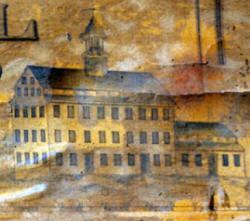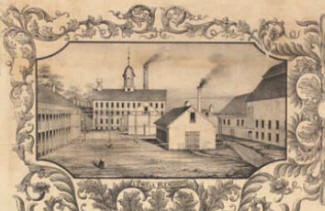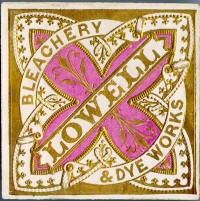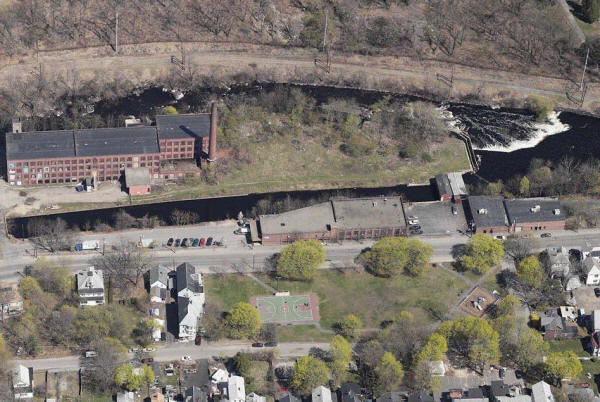History: Industrialization
Industrialization - Textiles

The first major textile factory on the Concord River was
constructed in 1813 and acquired five years
later by Thomas Hurd. |

The Middlesex Mills (left) began in
1836 and was the largest woolen mill on the Concord River.
|
High Water Mark
The early 1880s saw the largest number of textile
firms operating along the Concord River in Lowell. These firms
included the Belvidere Woolen Manufacturing Company’s factories at
Howe Street and Lawrence Street; John Holt’s bunting mills at
Davidson Street; the Chase Mills, L. W. Faulkner & Sons Mills, and
the Stirling Mills along the Wamesit Canal; William Walker & Company
at Massic Falls; the United States Bunting Company at the foot of
Crosby Street on the Wamesit Power Company; and the adjacent George
Naylor carpet mills. While the smaller concerns employed 20 to 40
workers, the larger of these mills had 150 to 200 employees.
Additionally the large Middlesex Company’s mills and the Lowell
Bleachery, located respectively on the Concord and on Hale’s Brook,
employed hundreds of workers. Together the Concord River textile
mills provided as many as 2,000 jobs.

The Lowell Bleachery is pictured in this
1850 engraving . |

This Lowell Bleachery label is one of
the few remnants from this company that operated for nearly
100 years along Hale’s Brook. Courtesy the American Textile
History Museum.
|
The Long Decline
By the early 1900s a number of the smaller companies from the 1880s
were no longer in business, and the Faulkner Mills, which became one
of the larger concerns when it took over the Chase Mills, was itself
acquired by the giant American Woolen Company. Competition
from southern mills -- initially within the market for plain cotton
fabrics and then spreading into woolen goods -- became increasingly
acute by the 1920s. Nevertheless, companies along the Concord River
that engaged in the production of niche goods, such as fine worsteds
and bunting cloth, successfully competed in the larger textile
market well into the 20th century.

The nation’s largest woolen and worsted manufacture, the
American Woolen Company, acquired the Faulkner Mill in 1898
and operated it as the Bay State Mills for nearly three
decades. |
Although certain niche producers of textile goods, such as the
worsteds, remained relatively profitable, by the late 1920s, the
majority of New England’s textile manufacturing companies were
experiencing severe financial losses and many mills began shutting
down permanently. Along the Concord River, the American Woolen
Company’s Bay State Mill closed in 1932, and its large brick factory
building was subsequently demolished.

The United States Worsted Company operated the Musketaquid
Mills from 1909 until 1928. The factory was originally
erected in 1909 by Lowell’s Edwin J. Hylan, who was
associated with the New England Bunting Company, but he
immediately sold it to the worsted manufacturer. |
Another large concern, the United States Worsted Company, closed
its Musketaquid Mills on Howe Street. A few specialty producers,
including the Waterhead Mills of English immigrants and brothers
Otto and William Hockmeyer, remained in operation into the 1950s.
Nevertheless, the 1930s proved to be the end for many of the city’s
notable textile companies, including the Lowell Bleachery and the
Middlesex Mills, the two largest concerns along the Concord River.

This recently produced aerial view of Wamesit Falls and the
Wamesit Canal shows the remnants of the Hockmeyer family’s
Waterhead Mills, where workers finished corduroy and
velveteens until the 1950s. |
Hear corporate executive Richard Satin, President of Bradford
Industries, discuss the challenges
facing Lowell manufacturers today.
This text will be replaced with the video
|








